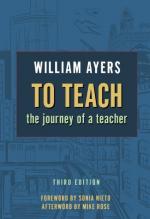
|
| Name: _________________________ | Period: ___________________ |
This test consists of 15 multiple choice questions and 5 short answer questions.
Multiple Choice Questions
1. According to Ayers, it is important for all teachers to be what?
(a) School Centered.
(b) Teacher-centered.
(c) Student-centered.
(d) Fair.
2. What do kids see that school is linked by more than anything else?
(a) By age.
(b) By sex.
(c) By subject.
(d) By development.
3. What kind of teachers did Ayers suggest were needed now more than ever?
(a) Experienced teachers.
(b) Kind teachers.
(c) Crusading teachers.
(d) Tired teachers.
4. When Ayers took children to the airport concourse, what did they do?
(a) The children ran.
(b) The children ate.
(c) The children watched people.
(d) The children sat down.
5. What did Ayers's space have "lots and lots" of?
(a) Clothes.
(b) Animals.
(c) Books.
(d) Boxes.
6. What model is curriculum built on based on Ayers's research?
(a) The surplus model.
(b) The teacher-centered model.
(c) The student-centered model.
(d) The deficit model.
7. What did Ayers say died at an early age for too many young Americans?
(a) Opportunity.
(b) Grandparents.
(c) Parents.
(d) Hope.
8. What does Ayers say the message should be to the children in youth?
(a) Focus on other students.
(b) You are a valuable person.
(c) You are here for an education.
(d) Do your best.
9. Who documented her classroom experiences through an impressive series of books?
(a) Kevin Sweeney.
(b) Maxine Greene.
(c) Hannah Arendt.
(d) Vivian Gussin Paley.
10. Ayers suggests that who "resisted the idea that there is some ideal child with whom they would be brilliant; they must reject the idea of social circumstance"?
(a) Administrators.
(b) Principals.
(c) Teachers.
(d) Parents.
11. Who believed that "Education was the point at which we decide whether we love the world enough to assume the responsibility for it"?
(a) Maxine Greene.
(b) Nel Noddings.
(c) Hannah Arendt.
(d) William Ayers.
12. How did Ayers stay alive as a teacher?
(a) Ayers knew it all.
(b) Ayers did not let things bother him.
(c) Ayers closed his mind to others.
(d) Ayers stayed open to mystery.
13. According to Ayers, what is built when there is an engaged and active citizenry?
(a) A strong democracy.
(b) Parental support.
(c) A republic.
(d) Better legislation.
14. Who was an exemplary teacher that argued that one central organizing goal in our schools must be the creation of communities of care and compassion?
(a) Mara Sapon-Shevin.
(b) Pat Carini.
(c) Eleanor Duckworth.
(d) Jose Vega.
15. According to Ayers, what should the larger goal of education be?
(a) Increased teacher pay.
(b) Complete overall of educational system.
(c) Adequate education for all children.
(d) Adequate education for 75% of children.
Short Answer Questions
1. What does Ayers state is part of the intellectual challenge of teaching, in addition to knowing students?
2. According to Ayers, what tells us what to do?
3. What type of music was played at the detention center during work time?
4. Who was the teaching assistant that pitched baseballs to a student everyday?
5. What did Duke bring to the attention of the other children about Mr. Ayers?
|
This section contains 470 words (approx. 2 pages at 300 words per page) |

|




